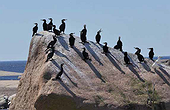Results of Nord Stream Environmental Monitoring Report for 2014
- Monitoring conducted in 2014 confirms positive trend in environmental recovery after construction.
- As with previous reports from 2010-2013, results established that the impacts from construction were limited locally and short-term only.
Aug. 13, 2015 | Zug | Nord Stream AG published the 2014 annual monitoring report, the fifth of six such planned reports. The report, which is intended to document environmental effects during the construction and recovery phases, summarises the results and conclusions of the monitoring activities in accordance with the five national environmental monitoring programmes in Russia, Finland, Sweden, Denmark and Germany. Data collected in 2014 have been evaluated against data collected in previous years. The results of the monitoring surveys carried out in 2014 confirm that the construction of the Nord Stream Pipeline has not had any adverse on the environment. This points to a positive trend in line with the findings of the previous years’ reports.
- The monitoring surveys carried out in Russia covered water quality, seabed topography, onshore soil, landscape, air quality, noise, fish and plankton, birds, marine mammals, benthic flora and fauna, and terrestrial flora and fauna. On the basis of these results and those of previous years it was concluded that the construction and subsequent operation of the Nord Stream Pipeline has had no negative impact on onshore soil quality, landscape, noise levels, seabirds, marine mammals or benthic communities. The 2014 monitoring also highlights an increase in terrestrial fauna species diversity in the area.
- Monitoring activities in Finland in 2014 showed that the construction of the Nord Stream Pipeline had no impact on hydrography, seabed topography or benthic fauna. The location and condition of known wrecks and munitions were also monitored: the results will be presented later in 2015. The epifauna survey at Kalbådagrund, near the Natura 2000 area, showed that all habitat types classified during the 2008 survey were also identified in the 2014 survey. The most common benthic species were similar in both surveys.
- The 2014 monitoring surveys carried out in Sweden and Denmark covered, among other subjects, fish populations, which were evaluated against data collected in previous years. In general, the monitoring results showed an increase in abundance and biomass since 2011. It can be verified that with regards to the amount of fish along the pipeline there is a negligible change when comparing impact and reference areas for each year, and it was concluded that the abundance of fish along the pipeline had only seasonal changes since the presence of the Nord Stream Pipeline.
- The monitoring surveys carried out in Germany in 2014 covered, among others, seabird and benthic communities. No measurable impact on the number of wintering seabirds was detected. The final investigation of infauna focused on the recovery of benthic fauna within the temporary sediment storage area and confirmed its full recovery since 2011, as expected.
The environmental and socio-economic monitoring started in 2009 and is focused on environmentally sensitive areas and other receptors that could potentially be affected by the Nord Stream Pipeline. Monitoring related to construction activities was conducted until 2012, when construction of both pipelines was completed. The results confirmed that the impacts were, if any, limited locally and short-term only, and thus in line with the outcome of the environmental impact assessments. The remainder of the monitoring programme has been focusing on the operation of pipelines and environmental recovery after construction. In accordance with the national monitoring programmes, a number of surveys detailing the successful recovery were concluded in 2014.
The Environmental and Socio-economic Monitoring Report 2014 is available for download here.





